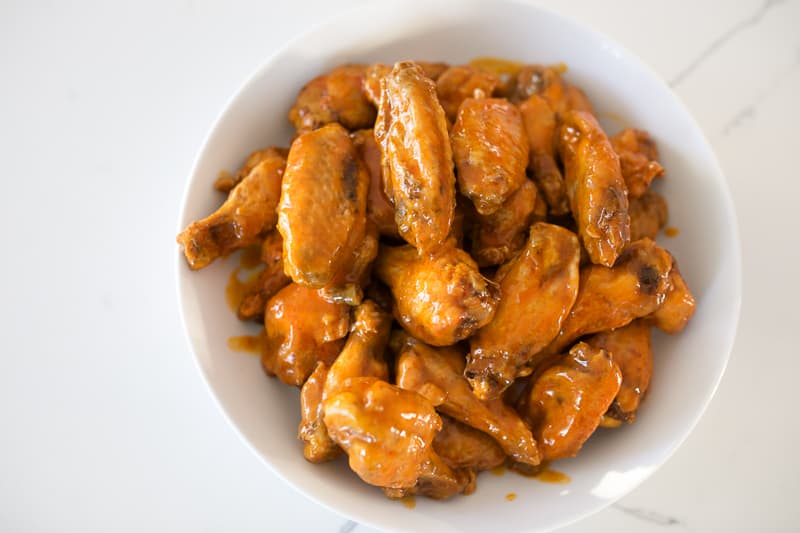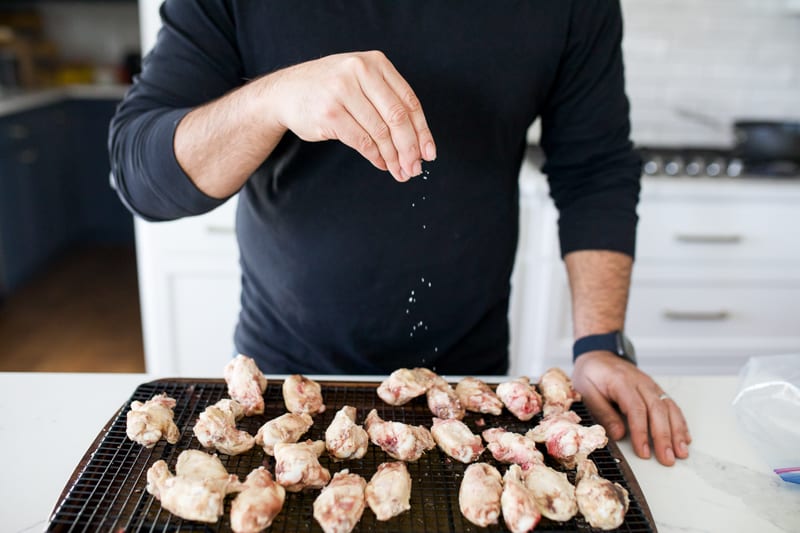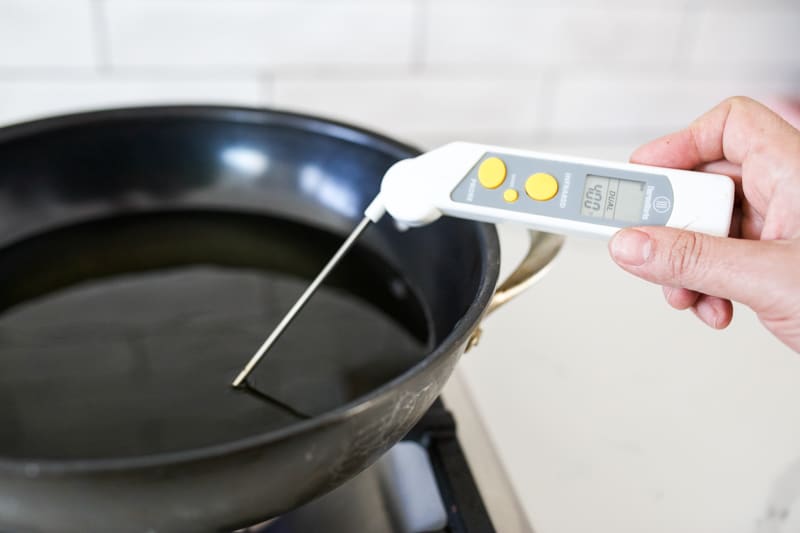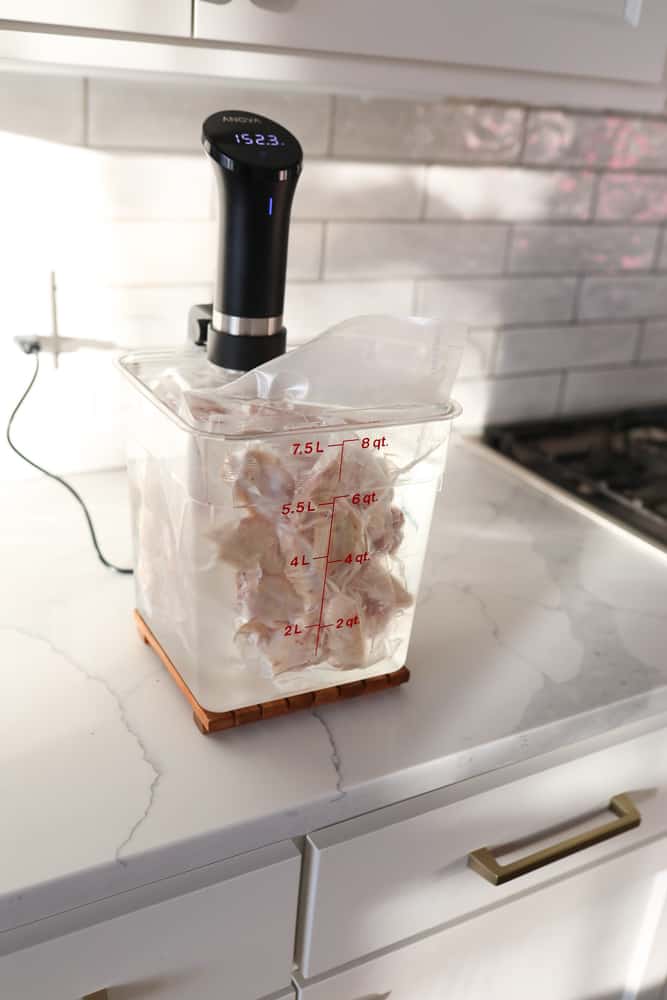No one wants to bite into an undercooked chicken wing. Not only could the raw taste and texture put you off of your favorite food for life, but you could also get seriously sick. Knowing your chicken wing internal temp is key.
There’s a ton of misinformation out there about cooking times and temperatures. Food safety was a major component of my culinary school experience. We had to memorize all the safe internal cooking temperatures for all meats as established by the USDA. But what’s safe isn’t the ideal temperature for chicken wings.
In this article, my aim is to set the record straight. We’ll discuss why 165°F is the “safe to eat” temperature and why wings cooked to 175°F are so delicious they’ll make your tastebuds sing. We’ll also cover the practical reasons why you should never eat an undercooked chicken wing.

Table of Contents
How to Tell When Chicken Wings Are Done
According to the USDA, any kind of chicken—from breasts to wings to thighs—must reach an internal temperature of at least 165°F.
To accurately measure internal temperature, you’ll want to remove the wings from the heat source. So pull a drumette out of the oven, air fryer, grill, or frying oil so the residual heat doesn’t affect the readings.
Then, stick a meat thermometer into the thickest part of the meat. Make sure to avoid the bone. Otherwise, you’ll receive a skewed reading. We measure on a drumette because the meat is thicker than on a wingette.
If the thermometer registers a temperature higher than 165°F, the wings are safe to eat. Otherwise, continue cooking them until they come up to temperature.
Chicken wings cooked to 165°F are safe to eat.
If you’re reheating wings, they need to reach the same 165°F temperature. At that point, all harmful bacteria are killed off, and the meat is fully cooked. Be patient rather than sorry.
Although 165°F is “safe to eat,” 175°F is by far the best internal temperature for wings.
Since wings are made up of dark meat, there is much more connective tissue that needs to dissolve and break down to create a tender, juicy bite. The tissue dissolves into gelatin at around 175°F, and that’s why this is the sweet spot for delectable wings.
How Long To Cook Chicken Wings
Now that you know what temperature the wings need to reach, it’s worth considering the best cooking method to employ. Here’s how to tackle chicken wings on a few of my favorites.

Oven
- Bake chicken wings in the oven at 400°F for about 40 minutes or until internal temperature reaches 175°F.
- Optional: Then, reduce the temperature to 170°F and bake them for an additional 20-30 minutes for an ultra crispy skin.
- Pro-Tip: Toss the raw wings in baking powder and salt before cooking to dry out the skin for a crispier finish.
Air Fryer
- Air Fry chicken wings at 400°F for 18 minutes or until internal temperature reaches 175°F.
- Cook on one side for 10 minutes, then flip and cook for the remaining 8 minutes.
- This method is best suited for dry-rubbed, thawed wings.
Deep Fry
- Fry in peanut oil that is 375°F for 10-12 minutes or until internal temperature reaches 175°F.
- To prevent splattering, remember to thoroughly dry the wings before adding them to the oil.
- Toss in dry seasonings or wing sauce after frying while the wings are hot.
Grill
- Grill chicken wings at 425°F for about 15-20 minutes or until internal temperature reaches 175°F.
- Make sure to flip them every 5 minutes or so for an even cook.
Sous Vide
- Cook chicken wings sous vide at 160°F for 2 hours, which will will melt the collagen and result in tender, juicy wings.
- Alternatively, you could cook at 140°F for 3 hours or 175°F for 1 hour.
- You’ll have to fry the wings in small batches in 400°F oil for 3-4 minutes to achieve a crispy exterior.

Which cooking method is best for chicken wings?
Ultimately, it’s a matter of personal preference.
Baking them is a hands-off approach. Air frying is a healthier alternative to deep frying. And grilling or smoking is a great way to cook a large number of wings at once for a party or event.
Believe me. Once you taste sous vide chicken wings, you’ll never go back. Sous vide cooking allows you to maintain the perfect temperature for an extended period of time. This results in the most tender, juicy, and flavorful wings ever.
Plus, it’s super easy to cook wings from frozen with the sous vide method, so it’s a convenient, no-fuss alternative to the other methods. It also lends itself well to par-cooking large batches of wings. If you need help planning the number of wings for a party, read: How Many Wings in a Pound? Tips for Party Portion Planning.

The Bottom Line
Chicken wings must be cooked to an internal temperature of 165°F or above to be safe to eat.
Wings cooked to 175°F are the juiciest and most tender because the collagen or connective tissue melts at this temperature.
There are plenty of different cooking methods that you can use to make a batch of wings, but if you have the time, you should try cooking them via sous vide.
You can cook sous vide wings from frozen or use thawed ones. Either way, the results are ultra-moist and fall-apart tender wings that are as tasty as they are addicting.
So go pick up some wings from the grocery store, and don’t forget your favorite wing sauce, and let’s get cooking! On that note, what are boneless wings anyway?
FAQs
Chicken is safe to eat once it reaches an internal temperature of 165°F. However, the sweet spot for a fully cooked, tender, and moist chicken wing is 175°F.
Color isn’t always an accurate indicator of doneness. Remember that dark meat or meat that’s closest to the bone will be pinker in color. However, as long as the thickest part of the meat registers at least 165°F, the chicken is fully cooked and safe to consume, even if there’s still a pinkish hue.
It’s possible that you could contract a foodborne illness or food poisoning from consuming undercooked chicken. If you start to experience symptoms such as stomach pain or cramping, nausea, vomiting, or diarrhea, seek a medical diagnosis immediately.

